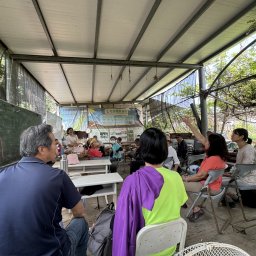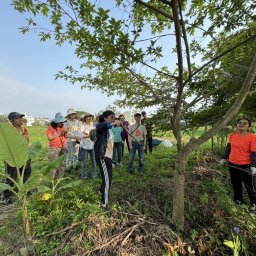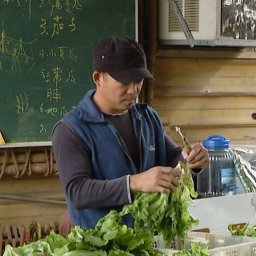
招生人數:31人
招生狀態:
額滿
課前資訊
這門課適合誰?
樸門永續設計結業、食農教育人員、社區規劃師、農夫、擁有土地、站在生態第一線的人,我們都歡迎!
需要準備的工具/軟體?
耐髒的衣服、雨鞋、手套、花剪、合用的鋸子。場地費 400 元另計。
上課會用甚麼方式進行呢?
資料討論&農場植物群種植實作
評量方式
學員出席率 50%、期末成果展 30% 行動分享 20%
課程簡介
課程QR CODE網址

本課程的主軸是希望讓大家清楚,什麼是「食物森林」、「食物森林的願景」以及可食森林園藝如何與樸門永續設計整合,著眼於食物森林的概念形成和文化背景,同時介紹森林園藝在重新融入自然世界中的潛力的願景,以及由此願景產生的食用森林花園設計目標。
課程目標
一、建立新竹幻象 CSA 基地可食森林的基調
藉由可食森林園藝(或說食物森林)的基本理論分享與實作,讓幻象 CSA 基地能夠「像森林一樣的種植」,朝向農業生物多樣性發展。
二、掌握植物群(plant guilds)的設計原則&在地化,產出實際的設計
植物群是發展可食森林園藝的基本工作,辨識區塊(patches)的棲地特性,選定主題作物,並且把同棲位的支持性植物也種植進來,形成一個植物群。我們希望發展更多在地植物群的案例,記錄下來並且分享!
三、這一切都是繼續為在城鄉交界建立 CSA 生態農場做預備。
參考書目
藉由可食森林園藝(或說食物森林)的基本理論分享與實作,讓幻象 CSA 基地能夠「像森林一樣的種植」,朝向農業生物多樣性發展。
二、掌握植物群(plant guilds)的設計原則&在地化,產出實際的設計
植物群是發展可食森林園藝的基本工作,辨識區塊(patches)的棲地特性,選定主題作物,並且把同棲位的支持性植物也種植進來,形成一個植物群。我們希望發展更多在地植物群的案例,記錄下來並且分享!
三、這一切都是繼續為在城鄉交界建立 CSA 生態農場做預備。
《Edible Forest Gardens》~Dave Jacke&Eric Toensmeier 合著。(https://www.amazon.com/Edible-Forest-Gardens-2-set/dp/1890132608)
數位教材連結
否
課程相關費用
學分費
2 學分,700元
雜費(電腦、冷氣、場地、設備等費用)
場地費(不含冷氣)400
無
其他費用
報名費200元(不退費)
-
學員團體意外保險費:113-秋季班 200元
材料及其他相關費用(開學後,各班自行收取管理)
-
學員團體意外保險費:113-秋季班 200元
場地費 400,材料另計
| 課程介紹與認識 | 講師自我介紹、學員彼此認識、簡介課程內容大綱以及希望達成的目標。 選舉班代以及學員分組。 |
| 植物群(Plant guilds)是什麼?組成的要素有哪些? | 完整的介紹植物群,組成要素,並且介紹若干案例。 |
| 食物森林的目標 (Goals of Forest Gardening) | 或許每個人的食物森林有各自的規劃,但是有一些基本的目標,是大家共有的。我們有六個目標。 |
| 森林結構的五個要素(The Five Elements of Forest Architecture)(1) | 森林有五個要素,讓我們知道什麼是森林:植被層、土壤層、植被密度。 |
| 森林結構的五個要素(The Five Elements of Forest Architecture)(2) | 模式化和多樣性。這些基本要素定義了森林,當我們選擇植物並選擇在何時何地將其放置在森林花園中時,我們就是在仿效(pattern)這五個元素。 |
| 社會結構:棲地、關係與群落(Social Structure: Niches, Relationships, and Communities)(1) | 物種、物種的棲地以及物種之間的關係。 |
| 社會結構:棲地、關係與群落(Social Structure: Niches, Relationships, and Communities)(2) | 多物種間的交互作用:社會結構的框架&社會結構設計: 定位與策略 |
| 地表下經濟的結構(Structures of the Underground Economy)(1) | 解析:土壤肥力的自我更新 |
| 公共參與周 | 社大安排之公共參與活動 |
| 地表下經濟的結構(Structures of the Underground Economy)(2) | 土壤食物網(The Soil Food Web) 參與地表下的經濟(Dabbling in the Underground Economy) |
| 演替: 植被動態的四個觀點 (Succession: Four Perspectives on Vegetation Dynamics)(1) | 古典的線性演替及頂極相(Classical Linear Succession and Climax) 進化演替至變動鑲嵌穩定態(Progressive Succession to Shifting-Mosaic Steady State) 區塊動態: 越界和失衡(Patch Dynamics: Out of Line and Out of Balance) |
| 演替: 植被動態的四個觀點 (Succession: Four Perspectives on Vegetation Dynamics)(2) | 具一致性的Oldfield理論: 演替的驅力(A Unified Oldfield Theory: Successional Causes) 演替設計:應用四種模式(Succession Design: Using the Four Models) 總結:四種模式的共時性(Summary: The Simultaneity of the Four Models) 結業分享 |
講師介紹
現職:
蕃薯藤社會企業負責人。網路系統整合工程師(2000~2012)
e-learning 標準 SCORM- learning Object Metadata(LOM)研究(2004)
新竹鐵道藝術村裝置藝術展覽--Quiet Please** 系統規劃、建置與開發(2005)
工研院「網路近未來」系列講座策劃人,包含 12 個講座,探討 Web 2.0 邏輯、自由軟體、創用CC、網路次文化、網路語言藩籬以及台灣網路近未來等主題(2007.03~2008.03)
農委會科技處與輔導處的創新工作訓練創意
簡介:
e-learning 標準 SCORM- learning Object Metadata(LOM)研究(2004)
新竹鐵道藝術村裝置藝術展覽--Quiet Please** 系統規劃、建置與開發(2005)
工研院「網路近未來」系列講座策劃人,包含 12 個講座,探討 Web 2.0 邏輯、自由軟體、創用CC、網路次文化、網路語言藩籬以及台灣網路近未來等主題(2007.03~2008.03)
農委會科技處與輔導處的創新工作訓練創意
交通大學畢。曾任工研院創意中心擔任研究員、2011.02 樸門永續設計基礎課程(Permaculture Design Course, PDC)結業(授課老師:Darren J. Doherty)
2015.01 樸門永續設計進階課程「大地工程與水資源管理系統的目測技術」、樸門永續設計進階課程「社會性林業(Social Forestry)」結業(授課老師:Tom Ward, Peter Morehead)
2018 樸門設計教學與引導者認證(授課老師:Robyn Francis, 江慧儀)
專長:
2015.01 樸門永續設計進階課程「大地工程與水資源管理系統的目測技術」、樸門永續設計進階課程「社會性林業(Social Forestry)」結業(授課老師:Tom Ward, Peter Morehead)
2018 樸門設計教學與引導者認證(授課老師:Robyn Francis, 江慧儀)
網路系統整合
網際網路標準、網站規劃與設計
社區協力農業
部落格(Blog):
臉書(Facebook):
簡介:
網際網路標準、網站規劃與設計
社區協力農業
● 2019-10-14~2021-12-14 新北豊年國小 老師 新北市 代理老師>>
● 2021-10-14~2021-12-31 竹塹社大 講師 幻象合作農埸 講師群>>
專長:
● 2021-10-14~2021-12-31 竹塹社大 講師 幻象合作農埸 講師群>>
樸門永續設計實作
田園規劃設計
蔬菜的定植播種
部落格(Blog):
臉書(Facebook):
田園規劃設計
蔬菜的定植播種




 邱美玲 講師
邱美玲 講師
